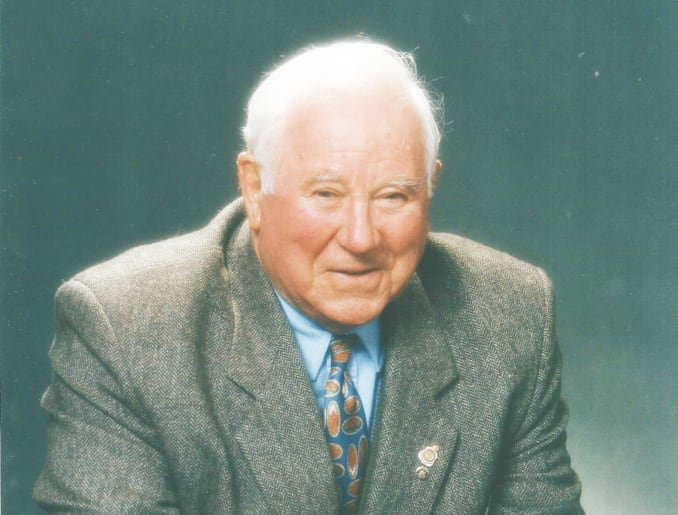
The late Ian Elder.
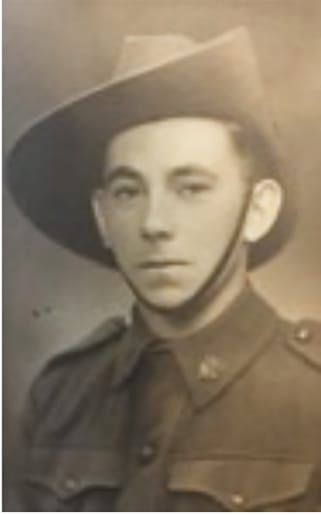
Ian Elder, 1943.
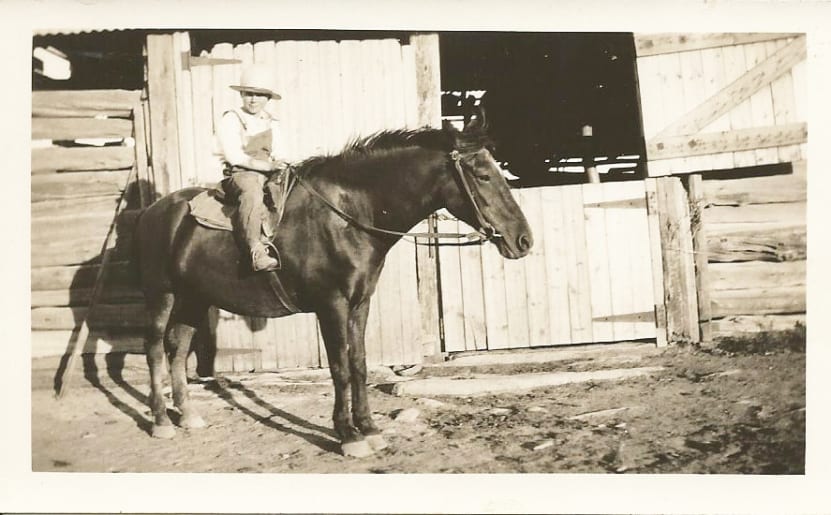
Ian Elder and pony, 1930.
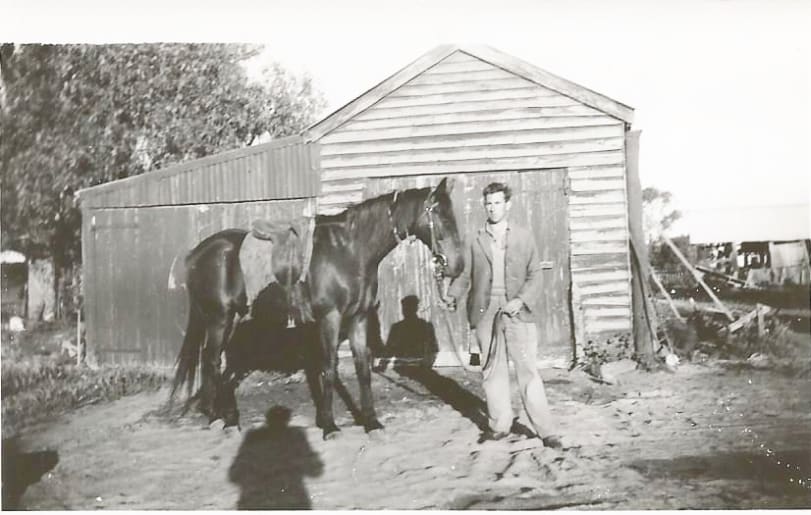
Ian Elder and “Finn” outside the old stables at “Elderslie”.
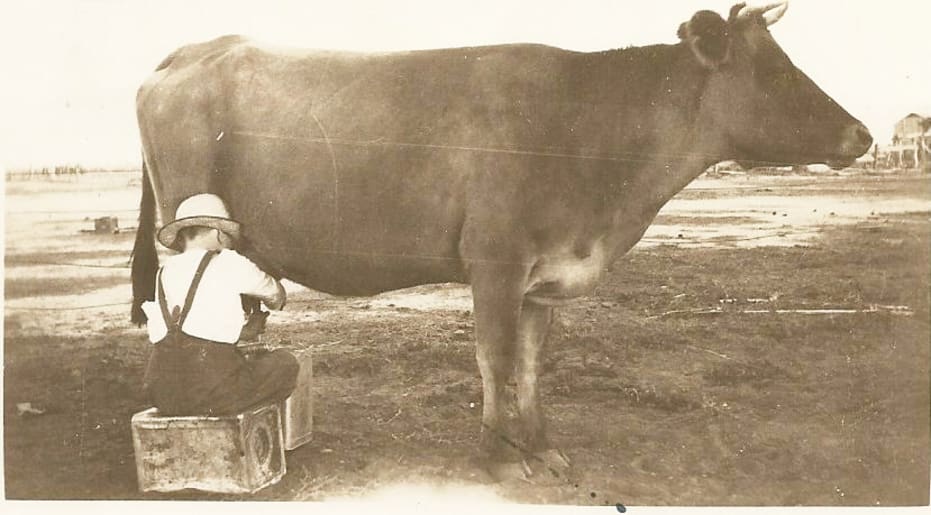
Ian Elder learning to milk a cow, “Elderslie”, December 1930.
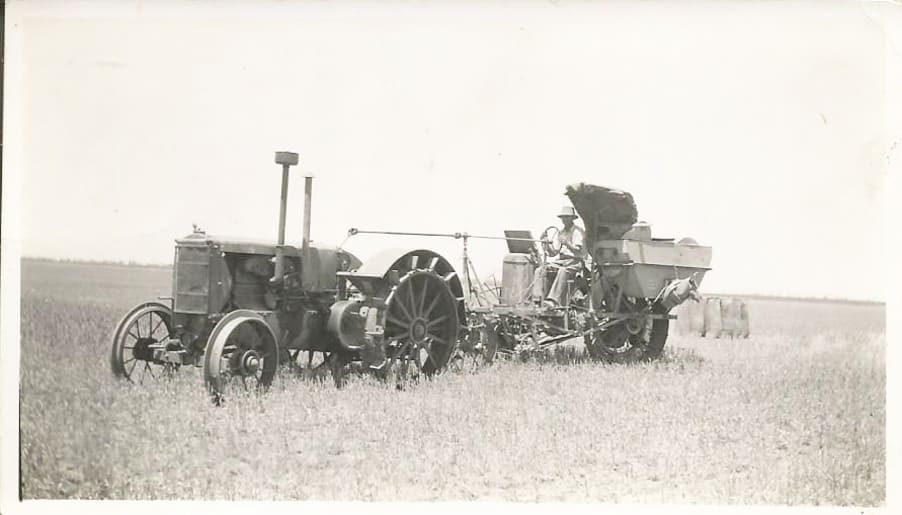
Ian Elder harvesting at “Elderslie” in 1950.
Ian George Stuart Elder was a family man, farmer and World War II veteran, with a life of community service.
After 97 years of involvement in the family farm along the Avoca River at Jeruk, Ian Elder had seen a lot of water pass under the bridge. His passing on May 24, 2021, marks the end of an era.
During his early years, Ian lived in Hamilton, where his father worked as a vet and a pharmacist. This was the era of the Great Depression, so payment was often by barter rather than cash.
When his father joined the Department of Agricultural, they moved to Melbourne and later Bendigo.
Ian spent most of his childhood holidays staying with his grandparents on the family farm, “Elderslie”, that his great grandparents had selected in the 1870s. After completing his secondary schooling, Ian started a Science course at the School of Mines in Bendigo, and worked on building sites before enlisting in the army in 1943. He was stationed in Papua New Guinea during 1944 and 1945, as Australian soldiers fought back the advancing Japanese. He never spoke much about the war years, but always showed great respect and appreciation for the local people in PNG. In the 1990s, Ian returned to PNG to volunteer on a building project to assist the local community.
Dookie
After returning from the war, Ian began a Veterinary course at Melbourne University in 1946, but found he couldn’t settle down. He then enrolled in an Agricultural course at Dookie. After completing this course, his uncle, who had taken over “Elderslie”, asked him to come back and work on the farm. During the years they worked together, he was given the impression that he was working towards taking over the farm. Therefore, it came as a shock to hear “on the grapevine” in town one day that the farm was up for sale. His uncle had no children and his other uncles had died in WWI and in an accident on the farm. His father and aunts were keen for the farm to stay in the family, so helped him buy most of the property. The very first crop he sowed was eaten out entirely by rabbits.
The early years on the farm on his own were quite lonely and he would regularly call on his cousins, the Bibbys, in Quambatook or neighbours, the Coateses, who recall Ian visiting and reading stories to them as children and then falling asleep himself on the couch.
Family
In 1954, he met Shirley Creelman, who was visiting relatives at the Millers. Romance blossomed and they married in 1955. They had three children; Robyn, Wendy and Robert. Robyn arrived prematurely during the 1956 flood.
To get to hospital, Ian used the tractor to tow the ute with Shirley in it across the paddocks until they could reach the road. Access to town was a challenge with rough and slippery roads, so they certainly didn’t just “duck into town”. Before being rerouted, the Jeruk River North Road followed along the river and was so precarious when it was wet that, apparently, you had to know just when to swerve on each bend, so that you didn’t end up in the river.
Income
Household income was supplemented by selling cream and eggs. The dairy cow was hand-milked and the cream separated, then put in large metal cans and delivered to the Glenloth railway station. The arrival of mains electricity was a significant development. This replaced the wind generator that had charged batteries for lighting and the kerosene lamps and fridge. However, there was a strict limit on the number of power outlets that they were initially allowed to install. The “party line” phone also provided some challenges. Ian would regularly have to go searching for where the galahs had been swinging on the wires and they had become crossed. Water was an issue but, with the help of a water diviner, a bore was sunk in the 1960s which provided a reliable water supply for stock and the house.
Changes
Over the years Ian saw many changes in farming in the district. As a child, he remembered riding his pony up to the back paddocks to see the Waranga channel being constructed by teams of horses pulling scoops. Later in his life, the pipeline was put through and the channel filled in by bulldozers. Initially, harvested grain was sewn into hessian bags and transported to Glenloth Station by horse and wagon, but through Ian’s lifetime, horses were replaced by tractors and they got bigger and bigger and bigger.
Having grown up during the Depression, it was hard for Ian to resist the bargains to be found at clearing sales. He used to enjoy travelling around with mates buying “lots” of things that might be useful, such as piles of old munitions boxes for storage and old army beds with wire bases and metal frames, that can still be seen around the farm today, as fence panels and gates. However, he never did seem to find a use for the jousting sticks that stayed propped in a corner of the shearing shed for many years!
Ian valued education and encouraged his children and grandchildren to make the most of opportunities. He always took an interest in what they were doing at school and their plans for the future.
His dining table and coffee table were permanently covered with newspapers, books, reports and old envelopes with “important” notes jotted on them as he continued to take an interest in local and world affairs.
Community Service
One aspect of Ian’s life that his family are particularly proud of is his involvement and commitment to community service. Robert, from a young age, remembers his father spending many hours in the evenings on the phone discussing issues and arranging meetings.
Over the years, Ian’s community service included:
- 1952 to 2000, member of CFA.
- 1955 to 2000, member of VFF, branch secretary for 6 years.
- Wycheproof School Council, 1963 to 1971; Chairman for 3 years, member of numerous delegations to the State Education Dept seeking elevation from HES to High School status and additional buildings.
- Wycheproof District Hospital Board.
- Wycheproof Show Committee.
- Charlton Shire Councillor, 1982 to 1995; Shire President 1986-’87.
- Member of the Charlton and Wycheproof RSL.
Ian was also passionate about water management along the Avoca River and the need to consider and manage the river system as a whole. He was involved in many consultative committees and management groups.
- 1981-1992, Avoca River Improvement Trust.
- Member of executive of the Association of Victorian River Management Authorities.
- 1990-’95, Avoca Dryland Salinity Management Consultative Committee.
- 1993-’95, chairman of the Avoca River Management Board.
- 1995-2000, member of the Avoca Implementation Committee in North Central CMA
- 2000, Wimmera Mallee Water’s Citizen of the Year award.
Shirley passed away in 2002, after being cared for by Ian at home during a long illness. Ian continued to live on the farm with his son Robert, daughter-in-law and grandchildren, into his 90s, and still enjoyed being involved in the Charlton Rotary Club and the Charlton and Wycheproof Probus clubs. He particularly enjoyed heading off for trips with the Charlton travel group. However, failing health and the loss of his driving licence, eventually necessitated a move to Bendigo. He lived with his daughter, Wendy, for a number of years before moving into a nursing home early last year.
Ian is survived by his 3 children, 9 grandchildren and 9 great-grandchildren.
Thank you to all who have expressed their condolences to the family. Ian was cremated in a private service in Bendigo due to Covid restrictions.





